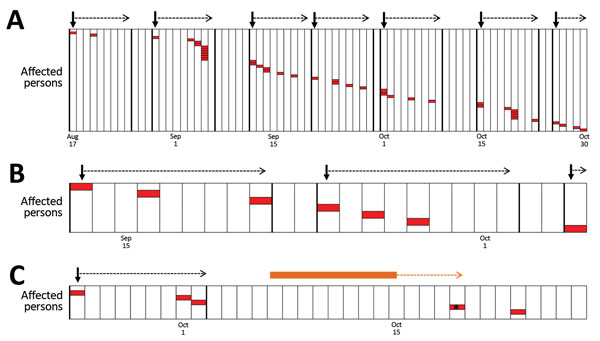Extended Human-to-Human Transmission during a Monkeypox Outbreak in the Democratic Republic of the Congo
Leisha Diane Nolen

, Lynda Osadebe, Jacques Katomba, Jacques Likofata, Daniel Mukadi, Benjamin Monroe, Jeffrey B. Doty, Christine Marie Hughes, Joelle Kabamba, Jean Malekani, Pierre Lokwa Bomponda, Jules Inonga Lokota, Marcel Pie Balilo, Toutou Likafi, Robert Shongo Lushima, Benoit Kebela Ilunga, Frida Nkawa, Elisabeth Pukuta, Stomy Karhemere, Jean-Jacques Muyembe Tamfum, Beatrice Nguete, Emile Okitolonda Wemakoy, Andrea M. McCollum, and Mary G. Reynolds
Author affiliations: Centers for Disease Control and Prevention, Atlanta, Georgia, USA (L.D. Nolen, L. Osadebe, B. Monroe, J. Doty, C.M. Hughes, A.M. McCollum, M.G. Reynolds); Minstere de la Santé, Kinshasa, Democratic Republic of the Congo (J. Katomba, J. Likofata, R. Shongo Lushima, B. Kebela Ilunga); US Centers for Disease Control and Prevention, Kinshasa (J. Katomba, J. Likofata, J. Kabamba); National Institute for Biomedical Research, Kinshasa (D. Mukadi, F. Nkawa, E. Pukuta, S. Karhemere, J.-J. Muyembe Tamfum); University of Kinshasa, Kinshasa (J. Malekani,); Kinshasa School of Public Health, Kinshasa (M.P. Balilo, T. Likafi, B. Nguete, E. Okitolonda Wemakoy); Minstere de la Santé Tshuapa Health District, Bokungu, Democratic Republic of the Congo (P.L. Bomponda, J.I. Lokota)
Main Article
Figure 4

Figure 4. Reconstruction of monkeypox virus transmission events in the Democratic Republic of the Congo by using an estimated incubation period. Each column represents a calendar day. Red boxes represent a single case of monkeypox infection. A cluster is defined as a set of case-patients that could have resulted from a single exposure and are delimitated with dark vertical lines. Dark arrows indicate the first case within a cluster, and the dotted arrow indicates the time during which a potential single exposure could have produced symptoms in the first person in that group to the last (i.e., 5–13 days). A) Transmission events in the village of Bokungu in the Democratic Republic of the Congo. B) A household with evidence of 3 known transmission events. C) A household with evidence of 1 known and 1 unknown transmission event. The orange bar represents the days when the case-patient, represented by an asterisk (*), would be expected to have been exposed.
Main Article
Page created: May 16, 2016
Page updated: May 16, 2016
Page reviewed: May 16, 2016
The conclusions, findings, and opinions expressed by authors contributing to this journal do not necessarily reflect the official position of the U.S. Department of Health and Human Services, the Public Health Service, the Centers for Disease Control and Prevention, or the authors' affiliated institutions. Use of trade names is for identification only and does not imply endorsement by any of the groups named above.
